What is Memorialization
Memorialization is when a state or an individual wishes to create an object, whether it‘s a monument, a poem, or even a film, to remember A certain event, series of events, or even a person for an extended period of time. Traditionally this would usually encompass a statue or monument that can be seen historically dedicated to great people.
But why look at the history of memorialization? Why look at old paintings and statues? Why look at recruitment posters? Because it shows us the values and the practices of the society at the time of its creation. When looking at Old Paintings of battles you can see what the leaders at the time wanted people to believe. The same is true for poems and songs. And you can see what attributes and values they want people to look up to and idolize with the memorials they build in memory of people and events. For example, by presenting the army as loyal to the last man, Unified in action and unwavering. It makes the army look like a formidable foe even if they aren’t and this can help increase recruitment and make enemies more hesitant to initiate conflict with you.
When looking at how Britain has memorialized the Army, you can see how the government wants the public to view them and how they want the international community to view them. This ranges from how it wanted the public at the time to view victories and losses in the Crimean war all the way to how it wants the public to view the second world war now.
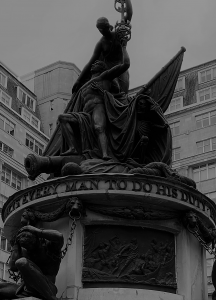
One of the best examples of memorialization before the Crimean war is the memorial built by the Liverpool city council In 1805 in honor of Lord Admiral Nelson after his successful naval campaign and its conclusion in the battle of Trafalgar, which led to the decisive naval superiority of the British Empire during the Napoleonic wars. The significance of this victory led to the creation of the statue.
The design shows Nelson on the top of a pedestal naked with a flag draped over parts of his body with death on one side And what appears to be Britannia above Nelson. As well as this there are also 4 chained prisoners sitting in positions of defeat, these represent Nelson’s four major victories. Around the side of the pedestal, there is the phrase “England expects every man to do his duty “which is written in very legible writing.
While the memorial was definitely created to remember Nelson and his victories it was also created to encourage people to enlist in the Navy. This can be seen by the overly heroic representation of Nelson himself with Britannia herself standing over Nelson holding him in her arms. And such a representation along with the phrase “England expects every man to do his duty.” can be seen as a call to action in his death. This is a piece of memorialization that also serves as a piece of propaganda to encourage service to the country, to both gain honor as Nelson did but to also ensure that his sacrifice wasn’t in vain. This is the starting piece in the trend of creating pieces to memorialize the dead and fallen but while doing so making the memorial a piece of propaganda
Before World War One
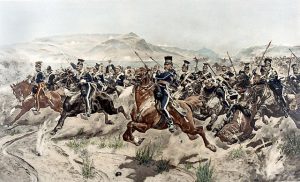
The battle the painting is based on and the poem by the same name is the battle of Balaclava. This was a decisive failure for the British forces. With the ‘charge of the light brigade’ being cut off resulting in casualty rates above 40% and the battle itself would lead to the Russian opponent gaining a much-needed morale boost and being able to hold their ground for much longer.
Despite the battle resulting in a failure, the photo presents a heroic charge forward, in which cowardice Swayze no man. Where the sacrifices that are all around each rider hold no effect on them. This is another example of the glorification of service within the army. As well as this presents a level of ignorance to the failure of the leadership.
However, the poem written by Alfred Lord Tennyson, took a less flashy approach, not portraying the charge as heroic, he comments on the foolishness of the charge itself saying that “someone had blunder’d.” This is in reference to the leadership’s decision to conduct the charge itself. but the soldiers that carried it out Are presented as courageous, despite knowing that somebody had made a mistake in the order they rode forwards “into the jaws of death.”
this is one of the earliest pieces of media that is accepted and advertised by the ruling classes despite not glorifying their leadership not having a wholly positive tone in general. This poem could be seen as an early precursor to the much more common poems of both world wars where there wasn’t a need to pander to the ruling class at the time and make the poem positive.
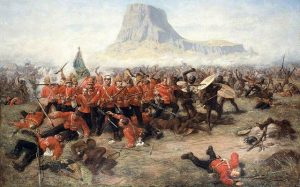
The painting is of the battle of Isandhlwana. This was one of the Large scale conflicts in the war with that being roughly 20,000 Zulus compared to roughly 1800 British soldiers. Despite the British having a decisive technological advantage. this was not enough to equalize the overwhelming numerical advantage the Zulus possessed, this led to the British losing the battle And the Zulus winning a decisive victory.
in a very similar manner to the charge of the light brigade painting. this painting isn’t about celebrating the British Empire’s decisive victory it is about how the soldiers were willing to fight until the very end. The painting is a great example of the mysticism that surrounded the British empire’s military with the painting depicting small troops of soldiers surrounded by a sea of enemies holding out till the last man despite the fact that friendly soldiers falling all around them. It solidifies the image of the stoic, capable, and strong-willed soldier that was commonly presented As it was in the charge of the light brigade.
During World War One
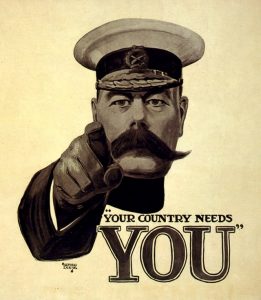
World War One and World War Two changed how memorialization was conducted in major ways. This is because of the high death rates among soldiers and the massive population loss across Britain. Due to this mass death that came from the first and Second World War, there was no glory to be found within war anymore. This led to a change in the approach the ruling classes approached memorialization and propaganda.
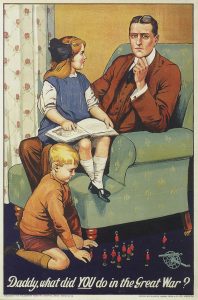
World War One saw the majority of the drastic change with the opening of the war. Having traditional methods of recruitment and in place for example the “your country needs you” poster is a very traditional call to arms for the owner of your country and the duty of your kinsman. the idea that it was a privilege to serve. However, as the war went on and more and more people came back with injuries or died the glory that was once seen in the war faded quickly. How’s the glory that was once utilized by the states to recruit soldiers faded didn‘t attempt to reinvigorate it, rather they shifted to guilt-tripping not seen with the “Daddy what did you do in the war.” Among many others. While at the time These would have been recruitment posters as times gone we have associated them strongly with the first World War, those making them a form of memorialization house whenever you see the posters or these images the first thing you think of world wars.
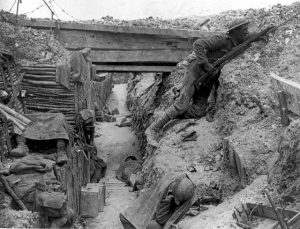
The lack of restriction on the publication of poetry also allowed for the truth to travel from the frontline to the home front in a manner that it hadn’t been able to previously. at all with some full truth. People got to see war for what it truly was. search poets as Wilfred Owen and Siegfried Sassoon helped in this greatly, with their depressingly truthful, painful, and bitter poems. This along with growth in technology also led to war photography beginning to exist. This meant that paintings became less and less necessary to deliver information from a battlefield to the public. Instead, photos could be used. This leads to more Realistic conditions being shown in the trenches The Dirty cramped living spaces that soldiers had to go through, the chance the trenches might flood, and course mass trench foot. The now-famous photo above is evidence of that. This soldier is in a german trench at the battle of the Somme and completely alone beside the cameraman. This helped bring home The information necessary to remove all of the preconceived notions of glory when it comes to war.
After World War One
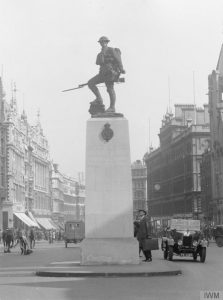
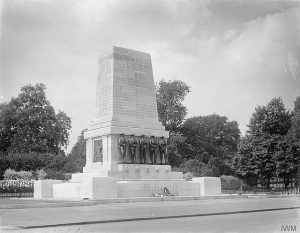
When the war was finally over and it was time to commemorate the sacrifices made. a new style of the statue was made not one that had the general standing atop a podium with the embodiments of Britain holding them off rather a lonely soldier, an artillery squad with injured, or perhaps a list of names on marble with a few statues of regular soldiers in front of it. All of these statue designs have a very quiet sad and morbid nature about them.
While they may be big monuments they’re not overly detailed. The very reason many incorporated lists of the dead was because the bodies couldn’t be recovered from the war so there was no place for the families to mourn. that is also the very reason that they tended to be guarded by featureless soldiers To signify the very people on the list. The glorious British soldier was gone, what was left was a respectful reserved soldier. that is what was presented on all of the monuments.
During World War Two
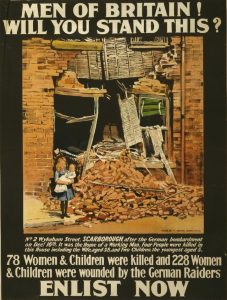
The shifting propaganda between the first and Second World War was from guilt-tripping the population into serving to try to encourage them through positive motivation. as well as showing them with damage that the Nazis had caused. As shown in the poster Above. these posters were specifically designed to keep up morale at home and not encourage people to sign up, this is because conscription was enforced so the ruling class to worry about getting recruits. The shift taken here specifically is the posters themselves are not lying but they are exaggerating in a positive manner with some posters being “we beat them once will beat them again.“ this is to encourage people to not give up hope.
After World War Two
Post World War Two, a near-identical style of the monument was put up in comparison to the First World War, and many First World War monuments were re-branded as just World War monuments to encompass both. While the Second World War still had a high death rate the feeling and belief that the war was really over and that a time of peace had come was apparent.
Due to the further technological advances, films about the events within World War One and two or based on the events of World War One and two began to get produced. films like “went the day well?” and “Lawrence of Arabia“are both very well-received films based on the Second World War. As well as movies fictional books based around ideas in the Second World War began to get published and as time moved on and technology got more and more advanced, more films about these same events came out like “Dunkirk” and “the darkest hour.” These films continued the trend of popularising historical events to keep them in public memory.
but with these technological advancements came even more information from the front lines even quicker. whereas it used to be war photographers moving back and forward between fronts and poets shuffling the poems between each other hoping they could get them printed. now we have live transmissions to battlefields and soldiers have cameras on them to ensure that they’re following the rules of warfare. soldiers are taking interviews to explain their side of the conflict to the public and how it feels to fight. this technology is gone more and more advanced and it has become easier and easier to get a direct view of the battlefield and the direct viewpoint of soldiers In a permanent place that is the Internet. it’s become less and less necessary to do the traditional massage of memorialization.
Bibliography
https://www.collinsdictionary.com/dictionary/english/memorialize#:~:text=memorialize%20in%20British%20English,to%20honour%20or%20commemorate
https://journals.sagepub.com/doi/10.1177/1750635217698337
Britannica, The Editors of Encyclopaedia. “South African War”. Encyclopedia Britannica, 4 Oct. 2021, https://www.britannica.com/event/South-African-War. Accessed 1 January 2022.
https://www.historic-uk.com/HistoryUK/HistoryofBritain/Charge-Of-The-Light-Brigade/
https://poets.org/poem/charge-light-brigade
https://www.poetryfoundation.org/poets/wilfred-owen
https://www.londonremembers.com/memorials/edith-cavell-statue
https://www.english-heritage.org.uk/about-us/our-places/statues/
https://www.taylorfrancis.com/books/edit/10.4324/9781315673394/understanding-popular-culture-world-politics-digital-age-caitlin-hamilton-laura-shepherd
https://www.taylorfrancis.com/books/mono/10.4324/9781003102816/war-photography-john-taylor
https://books.google.co.uk/books?id=JwzIUz8aIk4C&printsec=frontcover&source=gbs_ViewAPI&redir_esc=y#v=onepage&q&f=false

